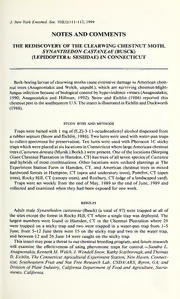
The Rediscovery of the Clearwing Chestnut Moth, Synanthedon castaneae (Busck) (Lepidoptera: Sesiidae) in Connecticut PDF
Preview The Rediscovery of the Clearwing Chestnut Moth, Synanthedon castaneae (Busck) (Lepidoptera: Sesiidae) in Connecticut
J. New YorkEntomol. Soc. 102(1):111—112, 1994 NOTES AND COMMENTS THE REDISCOVERY OF THE CLEARWING CHESTNUT MOTH, SYNANTHEDON CASTANEAE (BUSCK) (LEPIDOPTERA: SESIIDAE) IN CONNECTICUT Bark-boringlarvaeofclearwingmothscauseextensivedamagetoAmericanchest- nut trees (Anagnostakis and Welch, unpubl.), which are surviving chestnut-blight- fungusinfectionbecauseofbiologicalcontrolby hypovirulenceviruses(Anagnostakis, 1990; Anagnostakis and Hillman, 1992). Snow and Eichlin (1986) reported this chestnutpestinthesoutheasternU.S.TheinsectisillustratedinEichlinandDuckworth (1988). STUDY SITES AND METHODS Trapswerebaitedwith 1 mgof(E,Z)-3-13-octadecadienylalcohol dispensedfrom arubberseptum(SnowandEichlin, 1986). Twolureswereusedwithwater-pantraps to collect specimens for preservation. Ten lures were used with Pherocon 1C sticky trapswhichwereplacedatsixlocationsinConnecticutwherelargeAmericanchestnut trees Castaneadentata(Marsh.)Borkh.)werepresent. Oneofthelocations(Sleeping ( GiantChestnutPlantationinHamden, CT)hastreesofallsevenspeciesofCastanea and hybrids ofmost combinations. Other locations were orchard plantings at The Experiment Station Farm in Hamden, CT, and American chestnut trees in mixed hardwood forests in Hampton, CT (open and understory trees), Pomfret, CT (open trees), Rocky Hill, CT (canopy trees), and Roxbury, CT (edge ofa landscapedyard). Traps were set weekly from the end ofMay, 1989 to the end ofJune, 1989 and collected and examined when they had been exposed for one week. RESULTS Adult male Synanthedon castaneae (Busck) (a total of97) were trapped at all of the sites except the forest in Rocky Hill, CT where a single trap was deployed. The largest numbers were found in Hamden, CT in the Chestnut Plantation where 29 were trapped on a sticky trap and two were trapped in a water-pan trap from 1-5 June; from 5-12 June there were 15 on the sticky trap and two in the water trap, and between 12 and 26 June 14 were caught on the sticky trap. Thisinsectmayposeathreattoourchestnutbreedingprogram,andfutureresearch will examine the effectiveness of using pheromone traps for control.—Sandra L. Anagnostakis,KennethM. Welch,J. WendellSnow, KathyScarborough, andThomas D. Eichlin, The ConnecticutAgriculturalExperiment Station, NewHaven, Connect- icut; Southeastern Fruit andNut Tree Research Lab, USDA/ARS, Byron, GA; and Division ofPlant Industry, California Department ofFood andAgriculture, Sacra- mento, California. 112 JOURNAL OFTHE NEW YORK ENTOMOLOGICALSOCIETY Vol. 102(1) ACKNOWLEDGMENTS TheassistanceofKarenCentury,MaryInman,andPamelaSlettenisgratefullyacknowledged. LITERATURE CITED Anagnostakis, S. L. 1990. Improved chestnut tree condition maintained in two Connecticut plots after treatments with hypovirulent strains ofthe chestnut blight fungus. Forest Science 36:113-124. Anagnostakis, S. L. and B. Hillman. 1992. Evolution of the chestnut tree and its blight. Amoldia 52:3-10. Eichlin, T. D. and W. D. Duckworth. 1988. The Moths ofAmerica North ofMexico, Fas. 5.1,Sesioidea,Sesiidae.WedgeEntomol.Res.Found.,Washington,D.C., 176pp.,illustr. Snow,J. W.andT. D. Eichlin. 1986. Therediscoveryanddistributionoftheclearwingmoth, Synanthedon castaneae (Busck) in the southeastern United States. J. Agnc. Entomol. 3:66-67. Received and accepted 2 June 1993. J. New YorkEntomol. Soc. 102(1):112-114, 1994 ON THE NATURAL HISTORY OF CANOPIDAE (HETEROPTERA: PENTATOMOIDEA) In moist regions ofthe Neotropics, the undersides offallen trees are frequently coated with a layer of fungi which may be inhabited by a diverse assemblage of arthropods. While studying mycophagous Coleoptera in Costa Rica, Bolivia and Peru, I became acquainted with this unusual fauna which includes many heterop- terous insects; some mycovores (e.g., Aradidae), other predators (e.g., Reduviidae). Among the familiar residents were some slow moving, shiny black, hemispherical pentatomoids. A few specimens collected from several locationswere determined to be species ofCanopidae, aninfrequentlycollectedfamilywhosebiologyisunknown. The Canopidae include eight Neotropical species, with some additional names basedsolelyonimmatures(Slater, 1982),allbelongingtothegenusCanopusFabricius (McAteeandMalloch, 1928).ThemonogenericfamilyhasaffinitieswithScutelleridae and could also be closely related to Megarididae (McDonald, 1979). Canopidaewerefrequentlyencounteredduringthesefieldtrips;however,theywere onlycollecteda few timesaspart ofgeneral faunal samples. Althoughawidevariety offungal taxa and life stages are typicallyavailable, Canopidae are usually found on sporophores of certain fungi (especially thin encrusting polypores) and are often present as both adults and immatures, suggesting that the association with fungi is not incidental. The following are data for 49 specimens representing two species of Canopidae(depositedintheCornellUniversityInsectCollection)collectedbymyself
